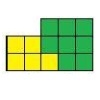Skip over navigation
You may wish to try the related problem Building Gnomons first.
A Gnomon is a rectangle with another rectangle cut out of one corner. The area of each Gnomon is a Fibonacci number. (The Fibonacci numbers are $1, 1, 2, 3, 5, 8$ and so on, with each new term being the sum of the previous two terms.)

$G_1$ has area $3$, $G_2$ has area $5$, $G_3$ has area $8$ and so on.
Draw the next three gnomons in the sequence.



Or search by topic
Number and algebra
Geometry and measure
Probability and statistics
Working mathematically
Advanced mathematics
For younger learners
Gnomon Dimensions
Age 14 to 16
Challenge Level 





You may wish to try the related problem Building Gnomons first.
A Gnomon is a rectangle with another rectangle cut out of one corner. The area of each Gnomon is a Fibonacci number. (The Fibonacci numbers are $1, 1, 2, 3, 5, 8$ and so on, with each new term being the sum of the previous two terms.)

$G_1$ has area $3$, $G_2$ has area $5$, $G_3$ has area $8$ and so on.
Draw the next three gnomons in the sequence.
Look at the length and width of the large rectangle from which each gnomon is made.

Is there a pattern to the lengths and widths?
Can you generalise?
Now look at the length and width of the rectangle cut out of each gnomon. Can you see any patterns here? Can you generalise and justify what you see?
I want to group the gnomons with area 3, 8 and 21 together, and the gnomons with area 5, 13 and 34 together. Can you explain why I want to divide these into two separate groups?
Can you give a convincing argument why all the gnomons fit into one of these two groups?
What other interesting patterns and relationships can you find?
You may also like
Searching for Mean(ing)
If you have a large supply of 3kg and 8kg weights, how many of each would you need for the average (mean) of the weights to be 6kg?
Building Gnomons
Build gnomons that are related to the Fibonacci sequence and try to explain why this is possible.


